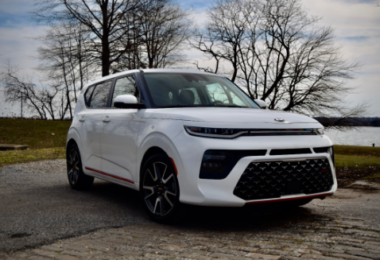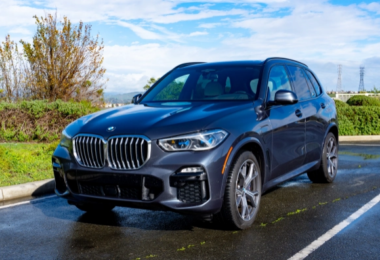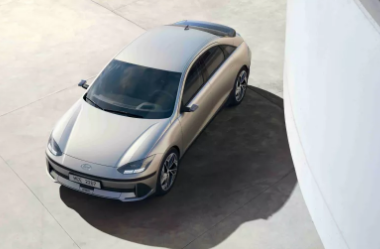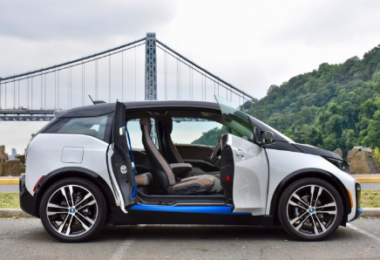The Hyundai Ioniq 5 is one of the top electric vehicles on the market right now. It has a large feature set, good range, lots of room, an attractive design, and a smooth ride.
It makes this electric SUV an appealing option for a variety of purchasers, from families to EV enthusiasts.

The Ioniq 5 distinguishes out from other EVs because of its distinctive bodywork, which is angular and has highlights in the style of pixels. Particularly attractive lighting features include the front and rear lights.
You enter and are welcomed by a fantastically roomy cabin. Although it may not have the most luxury feel and style, it is nonetheless cozy and useful.
Storage, cup holders, no fewer than four USB outlets, plus a wireless charging pad for your phone, are all provided by the sliding center console.
The dashboard is topped by two 12.3-inch touchscreens with thick bezels, with the infotainment system accessible from the central display. Although it loads slowly at times and the sat nav isn’t the finest we’ve experienced, it functions effectively.
However, there is support for Apple CarPlay and Android Auto, so you can use your smartphone to get more advanced mapping choices.
With real-world use, you won’t reach the Ioniq 5’s claimed range of up to 300 miles (WLTP), although it is possible to travel more than 250 miles. The additional benefit of 350kW charging support allows you to reach 80% in 18 minutes.
There are several helpful driving aids, such as adaptive cruise control and lane assist, while the side mirrors have cameras and show a live view of your blind area when you indicate.
The highlight of the Ioniq 5 is its vehicle to load (V2L) capability, which places a conventional power socket under the back seats and enables you to plug in items like laptops. Additionally, an adapter for its exterior charging connector is included, enabling you to use the Ioniq 5’s battery to charge other EVs.
You could also be able to get the Ioniq 5 with a solar panel roof, which can extend range by using the power of the sun, depending on where you live. It won’t be enough to fully recharge the battery, but it might be enough to add an extra 2,000km (1,243 miles) to your annual mileage for no further cost.
Due to the terrible weather in the UK, this option is obviously not available there, thus we haven’t had a chance to test it.
Overall, the Ioniq 5 is well-equipped, spacious, and enjoyable to drive. It merits your consideration without a doubt.
Hyundai Ioniq 5 price and availability
The base model of the Hyundai Ioniq 5 has a starting price of £36,995 (about $50,000 or AU$68,500), which is for a 58kWh, 170PS RWD (rear wheel drive) vehicle.
We drove the Ultimate RWD variant with a 73kWh battery, which increased the power output to 217PS, increased the range to 300 miles WLTP, and raised the cost to £44,890 (about $62,000/AU$83,000).
Our vehicle’s total cost, which included the Eco Pack ($1,195), Tech Pack ($1,495), and V2L Pack ($365), was £47,945 (about $65,000/AU$88,800).
The top-of-the-line Ultimate AWD (all wheel drive) model, which costs £48,090 (about $65,000/AU$89,000), accelerates faster quickly (0-62 mph in 5.2 seconds) and has more power (305 PS).
It implies that the Ioniq 5 will compete with the Tesla Model 3, Kia EV6, and Mercedes EQA.
In addition to many other international markets, the Hyundai Ioniq 5 is extensively accessible in the UK, all of Europe, and throughout the rest of the world.
The Ioniq 5’s launch has been postponed in the US, where it is now anticipated to happen in late 2021 or early 2022.
Hyundai Ioniq 5 design
Pictures of the Hyundai Ioniq 5 are deceiving. Its long wheelbase, somewhat low ground clearance and angular, squared-off form makes it look more like a hatchback than the crossover SUV it is.
In person, it’s able to get a better idea of the Ioniq 5’s SUV-esque proportions. It isn’t large, but it’s substantial – and its style gives it a forceful, aggressive and slightly futuristic aspect.
There are different character lines diagonally down each side, motion lines around the wheel arches, and the massive, 20-inch wheels themselves have their own unique design.
You’ll notice a ‘pixel’ motif throughout the car, but it’s most visible on the rear light block, which is made up of a number of square ‘pixel’ lights. It gives the Ioniq 5 a mixed, retro-modern appearance, which is both unique and eye-catching.
The wing mirror indicators are similarly made out of a row of pixel LEDs, while the headlights have a squared shape that looks almost threatening buried under the lip of the hood, staring out at the road ahead.
Completing the Ioniq 5’s unique light signature is the front bumper, which sees the top edge illuminated by a series of slim vertical light bars when the sun drops beyond the horizon. It’s another striking design detail, which, along with the other embellishments, give this electric car some real individuality.
The Hyundai Ioniq 5 is a head-turner and attracted a lot of attention during our time with it, despite the fact that it is not an expensive sports car. At a charging station, we even ran across an Ioniq 5 owner who was quite pleased with their base model, which they were using to great use as an Uber driver.
Here, the door handles spring out when you unlock the car and sit flush to the body, a feature that is becoming more and more popular as manufacturers of electric cars try to increase aerodynamics in any way they can for greater range.
You can unlock the car by pressing the button on the key fob, pressing your finger on the handle’s tiny square indent, or you can wait for the car to automatically unlock and present its handles when you approach because it has detected the key on you.
When you enter, you’ll find a roomy, light-filled environment that’s contemporary but uncluttered. In an effort to create a simple and useful environment, there are no signs of the Hyundai or Ioniq insignia, and it succeeds.
Inside, the car’s design language is tied together by a quartet of pixels on the steering wheel and decals on the door panels that continue the pixel theme.
The front seats are cozy, and the vehicle we were driving had the more expensive “Front Relaxation Seats,” which recline to an almost flat position. To make it easier for you to nap (or simply unwind) in your automobile, they come with an extra leg rest that rises up from the front of the chair. It’s a convenient choice for those times when you have to spend around 40 minutes at a charging station.
These seats also have cooling and heating options, but accessing them—as well as the heated steering wheel toggle—requires navigating through a few settings on the touchscreen. They become a little difficult to control when driving as a result.
To make them more convenient to use, we would have liked if these settings were placed to the climate control touch bar that is located below the display.
The two outer back seats are also heated, and it is simple to adjust them using the buttons on the corresponding door panels.
Since EVs lack a transmission tunnel and instead have a completely flat floor, Hyundai has taken advantage of this by mounting the batteries beneath the floor to increase interior space.
The dash is totally separated from the central console, giving the cabin an immediate feeling of increased space. There is also an open space between the front footwells.
The console may be moved back and forth to accommodate front- or back-seat passengers because it is mounted on rails. The armrest may be raised to reveal a small tray for holding phones or coins, and a wide area beneath it for stowing a bag.
The mood lighting in the cabin is another appealing aspect. All four door handles have lights that span their whole width, and each door panel’s circular speakers have a halo of light surrounding them.
You may adjust the hue and intensity to fit your mood or have them change based on the drive mode you’ve chosen. At night, it gives the area a futuristic appearance.
Adults may fit comfortably in the front and back, and the entire cabin has enough head and leg room. This makes the Ioniq 5 a formidable challenger for road trips and a fantastic family vehicle.
The spacious trunk, which provides room for several large luggage and several smaller bags in addition to an additional storage area under the hood, further strengthens these qualifications.
The hood can only be opened using a handle in the front footwell, although the powered tailgate can be opened remotely using the key. Although it’s a little less practical for daily usage, the extra room will probably be useful if you’re planning a lengthy vacation with a lot of bags.
Hyundai Ioniq 5 drive, range and charging
As previously mentioned, the Ioniq 5’s center console and dashboard are separated by a gap, so the usual location for the drive controls is not available. Instead, a steering column stalk is used to select Drive, Reverse, Neutral, and Park.
This stalk’s end twists to switch between Drive, Neutral, and Reverse, and a button at the end activates Park. It’s simple to use, and while it might take some time for those who are unfamiliar with this location to get used to it, it won’t take long.
Additionally, the Ioniq 5 offers three drive modes that can be selected using a button on the steering wheel. To switch between Eco, Normal, and Sport, simply press it. Normal provided the best daily driving experience, with a good balance of performance and range, according to our research.
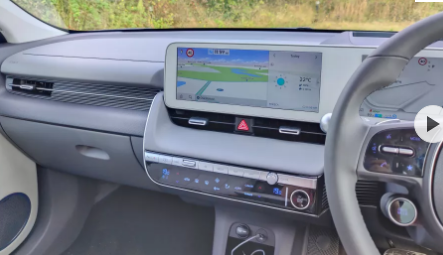
The fourth option, Snow mode, is also available and is activated by pressing and holding the same button.
The Ioniq 5 performs differently depending on the drive mode, and the digital cluster display changes as well, giving you a clear indicator of what you’ve chosen.
Acceleration is drastically reduced while regeneration is increased in eco mode. Contrary to expectations, Sport mode gives you a little bit more oomph underfoot and somewhat more responsive steering, while the difference between Sport and Normal is minimal.
While those numbers might not be particularly exciting, the rear-wheel drive EV’s 160kW of power is more than plenty for overtaking and pulling away from intersections.
With a mediocre 0-62 mph time of 7.4 seconds and a top speed of 115 mph, the Hyundai Ioniq 5 isn’t designed with speed in mind. If you choose the AWD version, the acceleration time drops to 5.2 seconds.
It also gladly rides at high speeds and maintains a quiet interior, which provides for a soothing experience.
Large windows and 360-degree cameras, along with the somewhat higher sitting position provided by the vehicle’s crossover SUV credentials, make it simple to view what is going on around you when driving and parking.
Although you’ll probably never obtain the Ioniq 5’s claimed 300 miles of range with real-world use, we were easily getting more than 220 miles on a full charge.
This should be plenty for the majority of return trips without causing too much range anxiety.
Drive at an average speed away from high speed highways and you may reach 250+ miles of range here. Switch to Eco mode to acquire a few extra miles of range.
You may adjust the amount of regenerative braking you experience when you take off the accelerator foot using paddle controls that are conveniently situated right behind the steering wheel. This gives you even another way to extend your range or, if you’d rather, enhance your driving performance.
The good news is that the Ioniq 5 supports charging speeds of up to 350kW, which Hyundai claims can recharge 80 percent of the battery in just 18 minutes when it comes time to top off that battery. You can reach 80 percent with a 50kW charger in 56 minutes and 30 seconds.
When utilizing a home charger, things go more slowly; a 10kW box can charge a battery to 100% in slightly over six hours. Even so, this is a good time to top off because it allows for overnight battery recharging.
Over the right-rear wheel is where the charging port is situated. When you press the appropriate key on the keypad while holding it down, a motorized flap that covers it opens.
Here, a stack of pixels displays a battery level gauge, giving you some more pixel action. To charge other devices as well—more on that in the section after—this port can be utilized in addition to charging the Ioniq 5.
Hyundai Ioniq 5 specs and tech
The Hyundai Ionia 5’s interior is equipped with two enormous screens, one of which is a 12.3-inch touchscreen located in the center and serves as the instrument cluster behind the steering wheel.
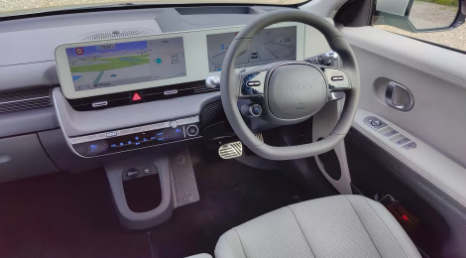
These displays have a noticeable bezel surrounding them, which gives them a practical rather than fashionable appearance. Nevertheless, they are clear, bright, and simple to use.
Although we occasionally found the touchscreen interface to be a little slow, overall it performed well. Additionally, you can choose between a light mode and a dark mode for the displays. The former is preferable during the day, while the latter works best at night because it is less distractingly bright.
The Ioniq 5 does not, however, offer an automatic feature, which is a little disappointing as it seems like a simple omission. You must manually choose between various settings. It might be a feature that is added in a later over-the-air software update.
Most of the time, the built-in navigation worked well, but it had issues with some of the addresses we provided. The good news is that you can connect your phone to the car using the USB port (located next to a 12v port at the base of the dash, between the two footwells) because the Ioniq 5 supports Android Auto and Apple CarPlay.
Additionally, this area has a cubby hole that is perfect for storing your connected phone out of the way. Access to essential programs, such as Google Maps and Apple Maps, is made possible by plugging in.
The Ioniq 5’s interface has a number of noteworthy features, including “Quiet Mode,” which is probably a favorite among parents.
When turned on, Quiet Mode creates a more peaceful environment for any passengers in the back by turning off the speakers in the back and reducing the volume of those in the front.
The Ioniq 5’s climate may be managed using a touch-sensitive bar that is located below the primary display.
While changing the drive mode will slightly alter the cluster’s appearance, there isn’t the same level of flexibility over which data is displayed where as on other EVs.
The blind spot camera, though, is a wonderful addition to the cluster display. The Ioniq 5 has classic glass mirrors instead of Hyundai’s fully digital wing mirrors, but behind each of them is a camera.
You can check your blind spot without turning around by indicating, which causes a live view from the matching side’s camera to appear on the cluster display.
Since drivers routinely check their blind spots, it took some getting used to – and trusting – this camera perspective. However, after spending a few hours behind the wheel, it started to feel a little more natural. If you drive the Ioniq 5 frequently, you will eventually get used to it.
These two cameras are also a component of the 360-degree video system for the automobile, giving the primary display a live image of the entire vehicle. This is particularly helpful for parking and navigating confined spaces.
Unexpectedly responsive, the Touch Bar makes adjusting the AC and heat settings simple. However, as we’ve already noted, there are certain settings on the screen above that you must go in order to control the heating and cooling options for the front seats.
Though there aren’t many customizing possibilities, the cluster display gives your speed and power levels a contemporary design.
Additionally, the Ioniq 5 may be remotely driven forward and backward if you find yourself in a particularly congested parking area or garage, allowing you to enter and exit the vehicle without having to slide down the side of the vehicle.
Unfortunately, during our time with the car, we were unable to make this function; but, you should be able to use the forward and backward feature from the key.
The Ioniq 5 also boasts a HUD (heads-up display), which projects essential driving information into your line of vision on the windshield, such as your current speed, the posted speed limit, and more.
This enables you to do so without having to take your eyes off the road or examine the information. It’s simple to read because the display is a reasonable size.
A variety of driving aids are also available, such as adaptive cruise control and lane assist. Long trips became less demanding thanks to this, however we discovered that the Ioniq 5 wasn’t always fantastic at staying in its lane; occasionally, we’d be clipping the lines and had to manually adjust the wheel.
There were so many occasions when the Ioniq 5 would beep at you, which was a little drawback. It occasionally felt as like we were being inundated with aural alerts, from the lane advice to the speed cameras and traffic signals.
These can be controlled in the settings, but it seems like Hyundai might improve the notifications by lessening their frequency and providing more information on the screen.
The Ioniq 5 has many choices for charging your gadgets and the devices of your passengers. There are three ports in the center console up front, including the USB port stated above for Auto and CarPlay. Additionally, there is a wireless charging pad that can top off compatible smartphones without the need to plug anything in.
There are two more USB connections at the back, allowing those there to access electricity. A genuine power outlet is also located under the center seat, allowing you to plug in electronics like laptops.
This plug is a part of the Ioniq 5’s V2L (vehicle 2 load) technology, which enables it to operate equipment typically plugged into a wall outlet. Although it should go without saying, laptops have many applications that are only constrained by your creativity.
You could, for instance, plug in a hairdryer, a fan, a heater, or even a small kitchen appliance like a kettle, microwave, or coffee maker while camping in order to inflate a mattress.
The Ioniq 5 can power a variety of things, not simply home furnishings and gadgets. You can connect in another electric vehicle, such a car or an e-bike, and charge it using the Ioniq 5’s battery thanks to an adaptor for the external power outlet.
The Ioniq 5 will stop charging when its battery reaches a particular level to guarantee you are not left stranded, so you won’t be able to entirely drain it by charging another vehicle.
It offers new and creative ways for us to use our cars and is simple to set up and use.
Should I buy a Hyundai Ioniq 5?
Buy it if…
All the devices, including other EVs, should be charged.
There are plenty of charging methods available for the Ioniq 5. The cabin has a full-size power outlet, a 12V plug, a wireless charging pad, and five USB ports. With the addition of the adaptor for the external socket, the Ioniq 5 may also charge other EVs.
You desire room for the family.
Families will like the Ioniq 5’s ample interior space and storage options, which include a trunk that is the right size and additional room under the hood.
You want a stylish, eye-catching electric vehicle.
The Ioniq 5 is an eye-catching, head-turning electric vehicle that is likely to draw notice everywhere it travels because to its distinctive design. It’s a great package when you factor in its outstanding feature set, strong range, and pleasant ride.
If… don’t buy it
You desire the best information technology.
Despite having a few entertaining and practical features, the Ioniq 5 doesn’t lead the market in some of the more fundamental controls. The lane assist should be improved, the sat nav is merely adequate, there are a few too many audible alerts, and it is annoying that the seat heating and cooling controls are tucked away in the touch interface.
You can also check https://whodey.xyz/garmin-drive-51-lmt-s-review-price-and-other-things-you-need-to-know-about-this-product/


